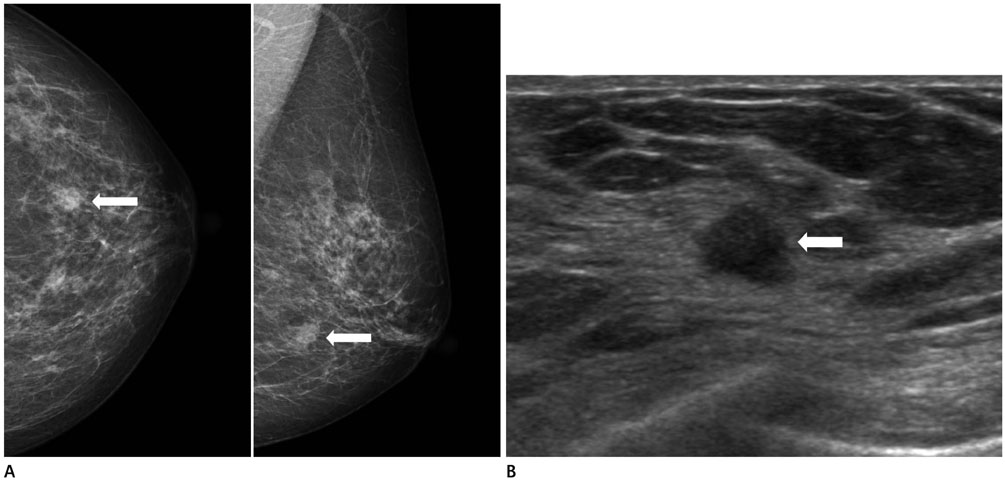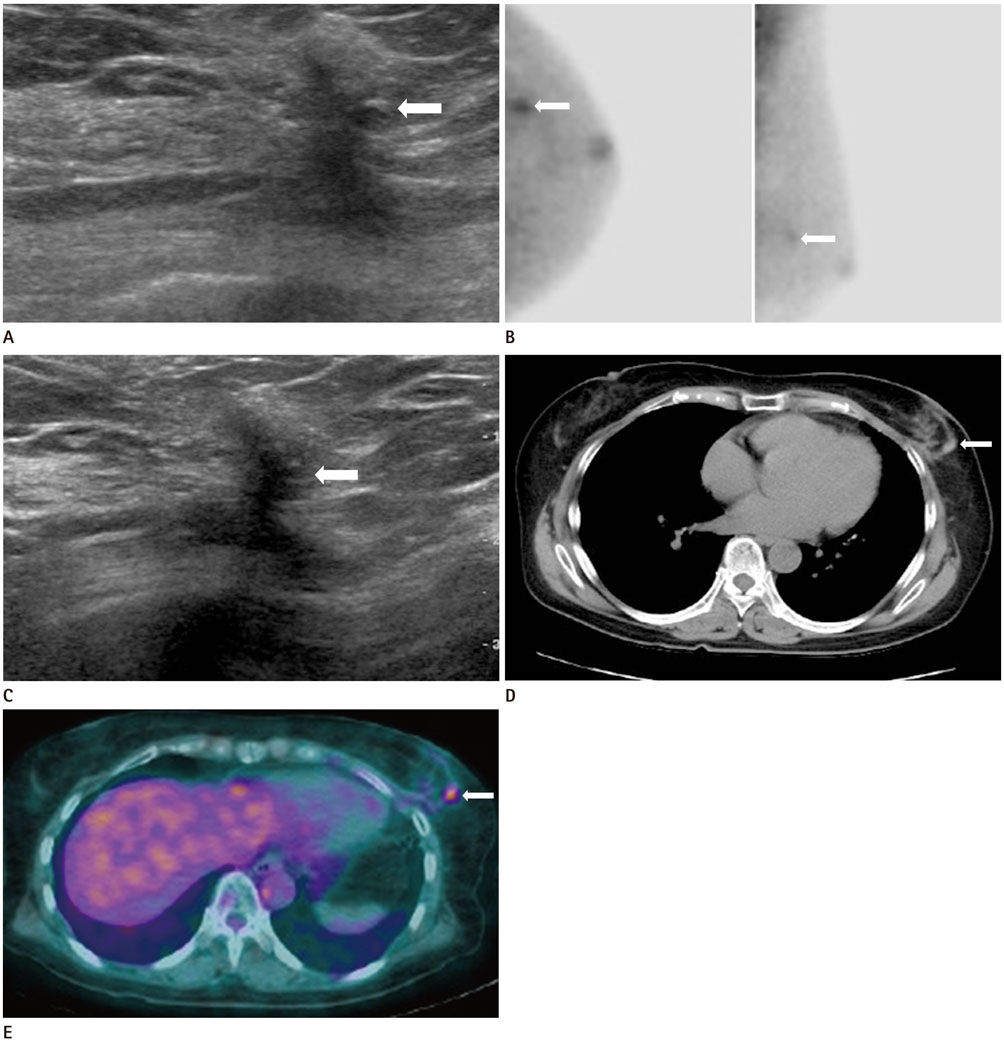J Korean Soc Radiol.
2016 Jul;75(1):57-61. 10.3348/jksr.2016.75.1.57.
A Case of Recurrence-Mimicking Charcoal Granuloma in a Breast Cancer Patient: Ultrasound, CT, PET/CT and Breast-Specific Gamma Imaging Findings
- Affiliations
-
- 1Department of Radiology, Myongji Hospital, Seonam University College of Medicine, Goyang, Korea. zzzz3@hanmail.net
- 2Department of General Surgery, Myongji Hospital, Seonam University College of Medicine, Goyang, Korea.
- 3Department of Pathology, Myongji Hospital, Seonam University College of Medicine, Goyang, Korea.
- 4Division of Hematology-Oncology, Department of Internal Medicine, Inje University Ilsan Paik Hospital, Goyang, Korea.
- KMID: 2327368
- DOI: http://doi.org/10.3348/jksr.2016.75.1.57
Abstract
- Charcoal remains stable without causing a foreign body reaction and it may be used for preoperative localization of a non-palpable breast mass. However, cases of post-charcoal-marking granuloma have only rarely been reported in the breast, and a charcoal granuloma can be misdiagnosed as malignancy. Herein, we report the ultrasound, computed tomography (CT), 18F-fluorodeoxyglucose-positron emission tomography/CT, and breast-specific gamma imaging findings of recurrence-mimicking charcoal granuloma after breast conserving surgery, following localization with charcoal in a breast cancer patient.
MeSH Terms
Figure
Reference
-
1. Langlois SL, Carter ML. Carbon localisation of impalpable mammographic abnormalities. Australas Radiol. 1991; 35:237–241.2. Patrikeos A, Wylie EJ, Bourke A, Frost F. Imaging of carbon granulomas of the breast following carbon track localization. Clin Radiol. 1998; 53:845–848.3. Ruiz-Delgado ML, López-Ruiz JA, Sáiz-López A. Abnormal mammography and sonography associated with foreign-body giant-cell reaction after stereotactic vacuum-assisted breast biopsy with carbon marking. Acta Radiol. 2008; 49:1112–1118.4. Kim YK, Park HS. Foreign body granuloma of activated charcoal. Abdom Imaging. 2008; 33:94–97.5. Lim ST, Jeong HJ, Kim DW, Yim CY, Sohn MH. F-18 FDG PET-CT findings of intraperitoneal carbon particles-induced granulomas mimicking peritoneal carcinomatosis. Clin Nucl Med. 2008; 33:321–324.6. Choi JW, Moon WJ, Choi N, Roh HG, Kim MY, Kim NR, et al. Charcoal-induced granuloma that mimicked a nodal metastasis on ultrasonography and FDG-PET/CT after neck dissection. Korean J Radiol. 2015; 16:196–200.7. Brem RF, Floerke AC, Rapelyea JA, Teal C, Kelly T, Mathur V. Breast-specific gamma imaging as an adjunct imaging modality for the diagnosis of breast cancer. Radiology. 2008; 247:651–657.8. Zhou M, Johnson N, Gruner S, Ecklund GW, Meunier P, Bryn S, et al. Clinical utility of breast-specific gamma imaging for evaluating disease extent in the newly diagnosed breast cancer patient. Am J Surg. 2009; 197:159–163.9. Goldsmith SJ, Parsons W, Guiberteau MJ, Stern LH, Lanzkowsky L, Weigert J. SNM practice guideline for breast scintigraphy with breast-specific gamma-cameras 1.0. J Nucl Med Technol. 2010; 38:219–224.10. Bonhomme-Faivre L, Depraetere P, Savelli MP, Amdidouche D, Bizi E, Seiller M, et al. Charcoal suspension for tumor labelling modifies macrophage activity in mice. Life Sci. 2000; 66:817–827.
- Full Text Links
- Actions
-
Cited
- CITED
-
- Close
- Share
- Similar articles
-
- False Positive of F-18 FDG-PET/CT due to Activated Charcoal Granuloma from Intraperitoneal Chemotherapy: A Case Report
- [11C]Choline PET/CT in a Patient with Prostate Cancer Biochemical Recurrence Showing Two Suspicious Findings in the Breast and Liver
- Unusual Horner's Syndrome in Recurrent Breast Cancer: Evaluation Using ¹â¸F-FDG PET/CT
- Charcoal-Induced Granuloma That Mimicked a Nodal Metastasis on Ultrasonography and FDG-PET/CT after Neck Dissection
- COVID-19 Vaccine-Related Axillary and Cervical Lymphadenopathy in Patients with Current or Prior Breast Cancer and Other Malignancies: Cross-Sectional Imaging Findings on MRI, CT, and PET-CT




